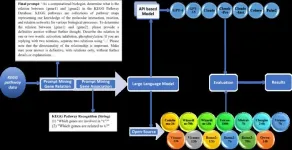Opening the right doors: “jumping gene” control mechanisms revealed
Researchers clarify the molecular mechanisms of chemical mark deposition to prevent “jumping gene” transcription
2024-07-11
(Press-News.org)
International joint research led by Akihisa Osakabe and Yoshimasa Takizawa of the University of Tokyo has clarified the molecular mechanisms in thale cresses (Arabidopsis thaliana) by which the DDM1 (Decreased in DNA Methylation 1) protein prevents the transcription of “jumping genes.” DDM1 makes “jumping genes” more accessible for transcription-suppressing chemical marks to be deposited. Because a variant of this protein exists in humans, the discovery provides insight into genetic conditions caused by such “jumping gene” mutations. The findings were published in the journal Nature Communications.
Disentangled DNA is often referred to as a “string.” In a cell, however, it looks more like a “string ball,” only the looping patterns are much more complex. The smallest unit is called a nucleosome. It consists of a section of DNA wrapped around a protein (histone) scaffolding. Transposons, genes that can “jump” to different locations in the genome, are “tucked away” in nucleosomes, which makes it difficult for the cell to deposit chemical marks that suppress transposon transcription. DDM1 is a protein known for maintaining such suppressing chemical marks, but it has not been clear how it can access transposons when they are neatly “tucked away.”
“Jumping genes are fascinating,” says Osakabe, the first author of the paper, “because they can cause significant changes in the genome, both good and bad. Studying how proteins like DDM1 manage these genes helps us understand the basic mechanisms of life and can have important practical applications.”
The researchers used cryo-electron microscopy, a technique capable of imaging at near-atomic scales. This allowed them to look at the structure of the DDM1 protein and DNA within the nucleosome.
“We felt very excited to see the detailed structures of DDM1 and the nucleosome,” Osakabe recalls. “One of the surprises was how DDM1 opens the nucleosome. It was challenging to capture these structures, but seeing the results made all the hard work worthwhile.”
The high-resolution images showed the exact positions where DDM1 bound to the DNA in the nucleosome. As a result, the specific binding site, which normally closes the nucleosome, got more “flexible” and opened up to allow suppressing chemical marks to be deposited, preventing transposons from being transcribed.
This seemingly minor detail could be the start of major improvements.
“The human version of DDM1, called HELLS, works similarly,” says Osakabe. “In the long term, such discoveries could lead to new treatments for genetic diseases in humans caused by similar genes. This new knowledge also provides insights into how plants and other organisms control their DNA, which could improve our ability to grow better crops or develop new biotechnologies.”
END
ELSE PRESS RELEASES FROM THIS DATE:
2024-07-11
Switching from a diet high in saturated animal fats to one rich in plant-based unsaturated fats affects the fat composition in the blood, which in turn influences long-term disease risk. A recent study published in Nature Medicine, conducted by a team of researchers from Chalmers University of Technology, Sweden, the German Institute of Human Nutrition, Germany and several other universities, shows that it is possible to accurately measure diet-related fat changes in the blood and directly link them to the risk of developing cardiovascular disease and type 2 diabetes.
“Our study confirms with even more certainty the health benefits of ...
2024-07-11
Bees and other beneficial bugs are disproportionately harmed by air pollution compared to crop-destroying pests, a new study published in Nature Communications has found.
Researchers from the University of Reading analysed data from 120 scientific papers to understand how 40 types of insects in 19 countries respond to air pollutants like ozone, nitrogen oxides, sulfur dioxide and particulate matter. Pollinators - including bees and some moths and butterflies - experienced a 39% decline in foraging ...
2024-07-11
For a long time, scientists associated crystal structures with an ordered arrangement of atoms in a repeating lattice-like pattern, believing it to be the most stable configuration. However, by the 1960s, advancements in crystallography revealed materials that did not fit the traditional model. These structures exhibit a non-periodic or non-repeating pattern and are called aperiodic crystals.
There are two types of aperiodic crystals: quasicrystals (QCs), which exhibit ordered but aperiodic arrangements, and incommensurately (IC) modulated structures, where a three-dimensional periodic lattice structure ...
2024-07-11
The possibility of hydrogen-powered flight means greater opportunities for fossil-free travel, and the technological advances to make this happen are moving fast. New studies from Chalmers University of Technology, in Sweden, show that almost all air travel within a 750-mile radius (1200 km) could be made with hydrogen-powered aircraft by 2045, and with a novel heat exchanger currently in development, this range could be even further.
“If everything falls into place, the commercialisation of hydrogen flight can go really fast now. As early as 2028, the first commercial hydrogen flights in Sweden could be in the air," says Tomas Grönstedt, Professor at Chalmers ...
2024-07-11
Some people lose weight slower than others after workouts, and a Kobe University research team found a reason. They studied what happens to mice that cannot produce signal molecules that respond specifically to short-term exercise and regulate the body’s energy metabolism. These mice consume less oxygen during workouts, burn less fat and are thus also more susceptible to gaining weight. Since the team found this connection also in humans, the newly gained knowledge of this mechanism might provide a pathway for treating obesity.
It is well known that exercise leads to the ...
2024-07-11
In Rhode Island, USA, over one in four emergency department (ED) patients at high risk of overdose has a non-fatal opioid overdose in the 18 months post-discharge. A parallel, two-arm, randomized controlled trial conducted in Rhode Island of over 600 ED patients at high risk of opioid overdose found that support from a peer recovery support specialist (a trained support worker with lived experience of addiction) was as effective in reducing opioid overdose as support from a licensed clinical social worker. In other words, interviewing and intervention techniques informed by lived ...
2024-07-11
Washington, July 11, 2024—Predictive algorithms commonly used by colleges and universities to determine whether students will be successful may be racially biased against Black and Hispanic students, according to new research published today in AERA Open, a peer-reviewed journal of the American Educational Research Association. The study—conducted by Denisa Gándara (University of Texas at Austin), Hadis Anahideh (University of Illinois Chicago), Matthew Ison (Northern Illinois University), and Lorenzo Picchiarini (University of Illinois Chicago)—found ...
2024-07-11
Understanding complex biological pathways, such as gene-gene interactions and gene regulatory networks, is crucial for exploring disease mechanisms and advancing drug development. However, manual literature curation of these pathways cannot keep pace with the exponential growth of discoveries. Large-scale language models (LLMs) trained on extensive text corpora contain rich biological information and can be leveraged as a biological knowledge graph for pathway curation.
Recently, Quantitative Biology published a study titled "A Comprehensive ...
2024-07-11
LA JOLLA, CA—Do you grab a fork and take a first bite of cake, or say no and walk away? Our motivation to eat is driven by a complex web of cells in the brain that use signals from within the body, as well as sensory information about the food in front of us, to determine our behaviors. Now, Scripps Research scientists have identified a group of neurons in a small and understudied region of the brain—the parasubthalamic nucleus (PSTN)—that controls when an animal decides to take a first bite of food.
In the study, published in Molecular Psychiatry on July 4, 2024, the team of scientists set out to selectively manipulate a group of PSTN cells that dial up their ...
2024-07-11
RIVERSIDE, Calif. -- Quantum computing, which uses the laws of quantum mechanics, can solve pressing problems in a broad range of fields, from medicine to machine learning, that are too complex for classical computers. Quantum simulators are devices made of interacting quantum units that can be programmed to simulate complex models of the physical world. Scientists can then obtain information about these models, and, by extension, about the real world, by varying the interactions in a controlled way and measuring the resulting behavior of the quantum simulators.
In a paper published in Physical Review B, a UC Riverside-led research team ...
LAST 30 PRESS RELEASES:
[Press-News.org] Opening the right doors: “jumping gene” control mechanisms revealed
Researchers clarify the molecular mechanisms of chemical mark deposition to prevent “jumping gene” transcription









